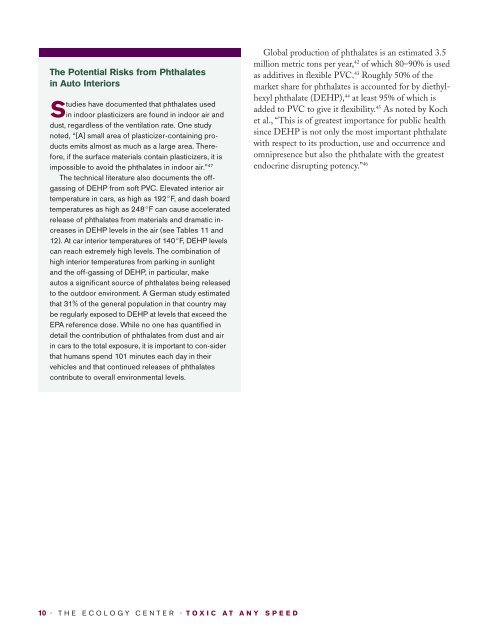Chemicals in cars and the need for safe alternatives
Chemicals in cars and the need for safe alternatives
Chemicals in cars and the need for safe alternatives
Create successful ePaper yourself
Turn your PDF publications into a flip-book with our unique Google optimized e-Paper software.
<strong>the</strong> Potential risks from Phthalates<br />
<strong>in</strong> Auto <strong>in</strong>teriors<br />
studies have documented that phthalates used<br />
<strong>in</strong> <strong>in</strong>door plasticizers are found <strong>in</strong> <strong>in</strong>door air <strong>and</strong><br />
dust, regardless of <strong>the</strong> ventilation rate. one study<br />
noted, “[A] small area of plasticizer-conta<strong>in</strong><strong>in</strong>g products<br />
emits almost as much as a large area. There<strong>for</strong>e,<br />
if <strong>the</strong> surface materials conta<strong>in</strong> plasticizers, it is<br />
impossible to avoid <strong>the</strong> phthalates <strong>in</strong> <strong>in</strong>door air.” 47<br />
The technical literature also documents <strong>the</strong> offgass<strong>in</strong>g<br />
of DEhP from soft PVC. Elevated <strong>in</strong>terior air<br />
temperature <strong>in</strong> <strong>cars</strong>, as high as 192°F, <strong>and</strong> dash board<br />
temperatures as high as 248°F can cause accelerated<br />
release of phthalates from materials <strong>and</strong> dramatic <strong>in</strong>creases<br />
<strong>in</strong> DEhP levels <strong>in</strong> <strong>the</strong> air (see Tables 11 <strong>and</strong><br />
12). At car <strong>in</strong>terior temperatures of 140°F, DEhP levels<br />
can reach extremely high levels. The comb<strong>in</strong>ation of<br />
high <strong>in</strong>terior temperatures from park<strong>in</strong>g <strong>in</strong> sunlight<br />
<strong>and</strong> <strong>the</strong> off-gass<strong>in</strong>g of DEhP, <strong>in</strong> particular, make<br />
autos a significant source of phthalates be<strong>in</strong>g released<br />
to <strong>the</strong> outdoor environment. A German study estimated<br />
that 31% of <strong>the</strong> general population <strong>in</strong> that country may<br />
be regularly exposed to DEhP at levels that exceed <strong>the</strong><br />
EPA reference dose. While no one has quantified <strong>in</strong><br />
detail <strong>the</strong> contribution of phthalates from dust <strong>and</strong> air<br />
<strong>in</strong> <strong>cars</strong> to <strong>the</strong> total exposure, it is important to con-sider<br />
that humans spend 101 m<strong>in</strong>utes each day <strong>in</strong> <strong>the</strong>ir<br />
vehicles <strong>and</strong> that cont<strong>in</strong>ued releases of phthalates<br />
contribute to overall environmental levels.<br />
10 • T h E E C o l o G Y C E N T E R • t o x i C A t A n y s P e e d<br />
Global production of phthalates is an estimated 3.5<br />
million metric tons per year, 42 of which 80–90% is used<br />
as additives <strong>in</strong> flexible pVC. 43 Roughly 50% of <strong>the</strong><br />
market share <strong>for</strong> phthalates is accounted <strong>for</strong> by diethylhexyl<br />
phthalate (Dehp), 44 at least 95% of which is<br />
added to pVC to give it flexibility. 45 As noted by koch<br />
et al., “this is of greatest importance <strong>for</strong> public health<br />
s<strong>in</strong>ce Dehp is not only <strong>the</strong> most important phthalate<br />
with respect to its production, use <strong>and</strong> occurrence <strong>and</strong><br />
omnipresence but also <strong>the</strong> phthalate with <strong>the</strong> greatest<br />
endocr<strong>in</strong>e disrupt<strong>in</strong>g potency.” 46

















